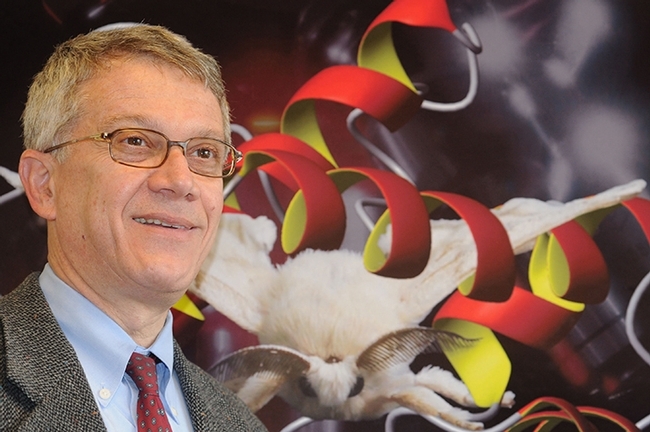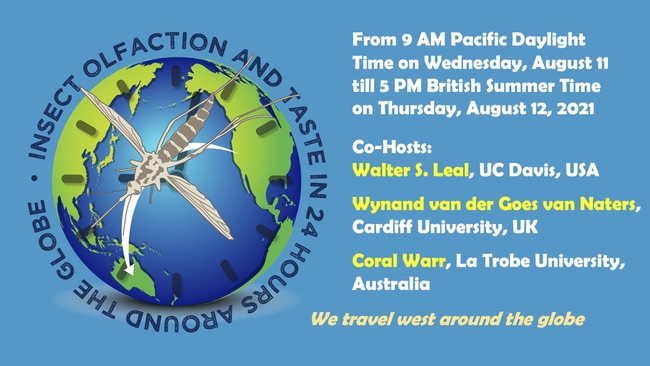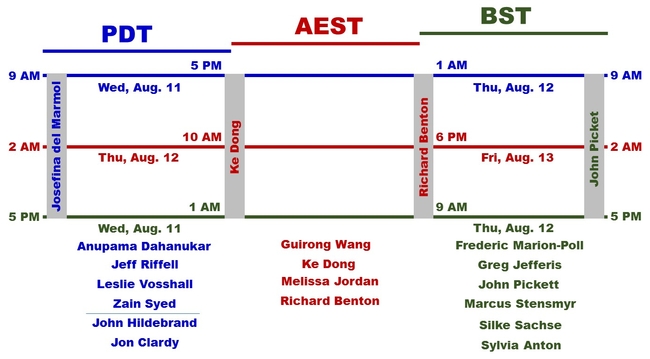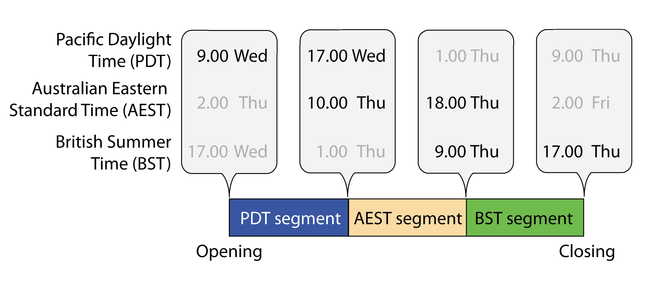- Author: Kathy Keatley Garvey

The 24-hour Zoom event, to begin at 9 a.m., Wednesday, Aug. 11, Pacific Daylight Time (PDT), will cover such topics as why mosquitoes are so persistent; the origins of insect olfaction; bitter perspectives (and insect taste); and novelty detection in the early olfactory processing of the honey bee.
“We will have 15 invited (keynote) and 36 contribution presentations,” said Leal, who will host the PDT segment. One of the interviews will feature olfaction research pioneer Karl-Ernst Kaissling of Germany.

Co-hosts with Leal are Wynand van der Goes van Naters of Cardiff University, UK, who will host the British Summer Time (BST) segment; and Coral Warr of La Trobe University, Australia (formerly of the University of Tasmania), host of the Australia Eastern Standard Time (AEST) segment. The trio, along with Karen Menuz (PDT), Wei Xu (AEST), and Emmanuelle Jacquin-Joly (BST), will moderate the symposium.

“The attendees will be engaged by questions and answers,” announced Leal, a UC Davis distinguished professor with the Department of Molecular and Cellular Biology and a former chair of the Department of Entomology (now the Department of Entomology and Nematology). “We will give priority to questions from students, postdocs, and early career professionals, but will attempt to address everyone's questions. Attendees can ask anonymous questions.” Many of the attendees would not otherwise have an opportunity to travel to an international symposium, he added.
The first segment--the PDT segment hosted by Leal--begins with a welcoming address by John Hildebrand of the University of Arizona, International Secretary of the National Academy of Sciences. Presentations by Josefina del Marmol of The Rockefeller University, New York, and Jon Clardy of Harvard Medical School will follow. “There will be four keynote lectures and 10 contributed presentations,” Leal said.
The last presentation in this segment, by Ke Dong of Duke University, will bridge with the AEST segment, hosted by Warr. It will include two keynote lectures and 14 contributed presentations. Then, a keynote lecture by Richard Benton of the University of Laussanne will bridge with the BST segment, hosted by van der Goes van Naters. It will include six keynote lectures and 12 contributed presentations. After the last lecture by John Pickett of Cardiff University) the symposium returns to UC Davis for closing remarks.
The list of keynote speakers and their topics:
PDT Segment
- Anupama Dahanukar, UC Riverside, Adaptive taste variation in Drosophila
- Jeff Riffell, University of Washington, The olfactory gating of visual preferences to human skin and colors in mosquitoes
- Leslie Vosshall, The Rockefeller University, Why are mosquitoes so persistent?
- Zain Syed, University of Kentucky, Insect olfaction in the era of genomes, transcriptomes, and proteomes
AEST Segment
- Guirong Wang, Chinese Academy of Agricultural Sciences, Molecular mechanism of olfactory coding in Helicoverpa armigera and its application
- Ke Dong, Duke University, A dual-target molecular mechanism of pyrethrum repellency against mosquitoes
- Melissa Jordan, Plant and Food Research, New Zealand, The origins of insect olfaction
- Richard Benton, University of Lausanne, Evolution of olfactory circuitry in drosophilids
BST Segment
- Frederic Marion-Poll, University Paris-Saclay, at AgroParistech, Bitter perspectives (and insect taste)
- Greg Jefferis, University of Cambridge, Olfactory circuits: whole brain connectomics to behavior
- John Pickett, Cardiff University, The role of chemistry in contextual olfactory signaling to insects
- Marcus Stensmyr, Lund University, Molecular basis of natural insect repellents
- Silke Sachse, Max Planck Institute – Jena, Olfactory learning modulates a neural circuit mediating innate odor-guided behavior in Drosophila
- Sylvia Anton, French National Institute for Agricultural Research, Plasticity in pest insect olfaction
------------------------------------------------------------------------------------------------------
The list of contributed presentations:
PDT Segment
- Ben Matthews, Molecular and neural basis of salt taste in mosquitoes
- Carolina Reisenman, Taste specializations in specialist Drosophila sechellia
- Chris Potter, Olfactory responses to insect repellents in Anopheles malaria mosquitoes
- Craig Montell, Drosophila receptors controlling chemical and textural taste sensation
- Erika Plettner, Mechanisms of molecular recognition of odorant-binding proteins
- Hany Dweck, Evolutionary shifts in taste coding in the fruit pest Drosophila suzukii
- Jason Pitts, Indolergic receptors in the housefly, Musca domestica
- Jessica Zung, Chemical signatures of human odour and implications for mosquito olfactory evolution
- Mahmut Demir, Dynamic switch between ON and OFF responses in an olfactory receptor neuron
- Preeti Sareen, A neuronal network for gustatory decision making under conflicting taste information in Drosophila
- Walter Leal, Swapping mosquito odorant receptor domains to probe specificity
- Zepeng Yao, Serotonergic neurons translate taste detection into internal nutrient regulation
AEST Segment
- Alice French, Sensory processing during sleep in Drosophila melanogaster
- Aniruddha Agnihotri, Unfolding the truth behind refolding of insect Odorant Binding Proteins
- Brian Smith, Novelty detection in early olfactory processing of the honey bee, Apis mellifera
- Chen-Zhu Wang, A gustatory receptor tuned to sinigrin in the cabbage butterfly Pieris rapae
- David Heckel, bric à brac controls sex pheromone choice by male European corn borer moths
- Helen Rushby, The role of olfaction in macronutrient balancing in Drosophila melanogaster
- Hidehiro Watanabe, Postembryonic development of sex pheromone reception in the American cockroach<
- Kosuke Tateishi, Functional analysis of odorant receptor co-receptor (Orco) in the antennae of the American cockroach
- Paul Cunningham, A blend of fruit and fungal volatiles shows promise for mass trapping female Queensland fruit fly
- Paul Szyszka, Rapid evolution of olfactory degradation in recently flightless insects
- Pinky Kain, Starvation and activity dependent modulation of salt taste in Drosophila
- Nobuaki Tanaka, A sexually dimorphic olfactory neuron mediates fixed action transition during courtship ritual in Drosophila melanogaster<
- Teruyuki Matsunaga, Evolution of olfactory receptors tuned to mustard oils in herbivorous Drosophilidae
- Yinliang Wang, Peripheral olfactory sensing of plant volatiles and their potentially applications in Northeast China
BST Segment
- Ben Paffhausen, A flying platform to investigate neuronal correlates of navigation in the honey bee (Apis mellifera)
- Bente Berg, Distinct protocerebral neuropils associated with attractive and aversive female-produced odorants in the male moth brain
- Danila Kolesov, Insect chemoreceptors in a mammalian chemogenetics
- Emmanuelle Jacquin-Joly, Function of odorant receptors in a moth
- Ilona Grunwald Kadow, A learning circuit is involved in mating state-dependent olfactory behavior of Drosophila females
- Jonathan Bohbot, Indolergic odorant receptors are an ancient feature of dipteran olfactory systems
- Julia Mariette, Functional study of the queen pheromone receptor OR11 in honey bees within the genus Apis
- Mario Pannunzi, Non-synaptic interactions in olfactory receptor neurons, a peripheral odour coding?
- Naoko Toshima, A rewarding and a punishing effect of amino acid taste in larval Drosophila
- Sharon Hill, Age matters: regulation of antennal transcription throughout a mosquito's first gonotrophic cycle
- Xi Chu, Neuronal architecture of the CO2 pathway in the brain of a noctuid moth
- Yael Grosjean, Adult sex-specific vigilance via olfactory receptor inhibition in Drosophila
The registrants hail from 66 countries: Algeria, Argentina, Australia, Austria, Belgium, Brazil, Bulgaria, Burkina Faso, Canada, Chile, China, Colombia, Costa Rica, Denmark, Dominica, Ecuador, Egypt, Ethiopia, Finland, France, Germany, Ghana, Greece, Guatemala, Hungary, India, Iraq, Ireland, Israel, Italy, Japan, Kenya, South Korea, Lebanon, Mexico, Mozambique, Nepal, Norway, Pakistan, Peru, Portugal, Puerto Rico, Réunion, Russia, Singapore, South Africa, Spain, Sri Lanka, Sudan, Sweden, Switzerland, Taiwan, Tanzania, Cayman Islands, Czech Republic, The Netherlands, The Philippines, United Kingdom, United States, Trinidad and Tobago, Tunisia, Turkey, Uganda, United States Minor Outlying Islands, Uruguay, and Vietnam.
For updates, videos and more information, follow Leal on Twitter at @wsleal2014.





